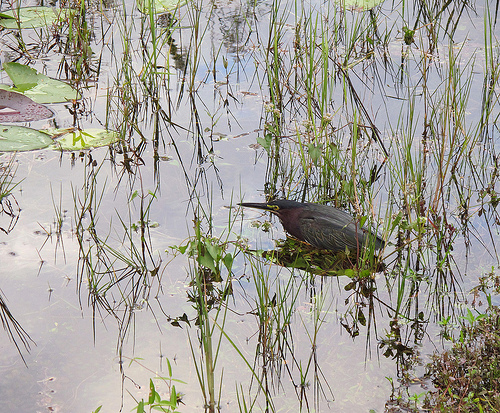
Artist In Residence In the Everglades (AIRIE) diary selection #4
This post is associated with artist and writer Christopher Reiger‘s 2-week-long Artists In Residence In the Everglades (AIRIE) writing and art residency in Everglades National Park.
Notes from Day 13: – I had an on-the-move photo shoot with an Eastern diamondback rattlesnake. As it crossed the road and flowed through the grass on the far side, it kept its head and one s-curve of its body angled toward me, prepared to strike were I to molest it. The encounter was a treat; I’ve long wanted to meet an Eastern diamondback outside of an enclosure and now I have! Like the cottonmouth I met earlier in my visit, this is a snake that I have no inclination to handle and examine more closely, so I don’t know it’s gender.
– Sadly, not far from where I came upon the rattler, I found a dead, partially crushed and ant-consumed rough green snake, a beautiful species that, when alive, is a radiant emerald; even dead, they are pretty snakes. Not counting insects or the dead dog wasting away on the roadside outside of park land (there are many dogs with apparently negligent owners living near the park), this is the 3rd dead-on-road (DOR) critter I’ve found. A red-shouldered hawk and a great blue heron also lost their lives to cars during my time here. Doubtless, there are many others that I didn’t happen upon.
– I had the privilege of joining Florida International University Honors College professors Peter Machonis and Devon Graham as they led their “Everglades: From beginning to end?” seminar class on a slough slog. Before we waded into the river of grass, I presented a short lecture on my artwork, the importance of biodiversity, and the Endangered Species Print Project (ESPP).
The real fun started about an hour later, when we stepped into the water. I’ve seen plenty of flora and fauna from the roads and trails in my two weeks in Everglades National Park, but sloshing through sawgrass marshes and into two bald cypress stands provided another, more sensuous prespective. We met countless spiders (all species unidentified, unfortunately), diminutive American green tree frogs, and Halloween pennant dragonflies (as well as other, unidentified dragonfly species) on our way to the cypress dome.
Once inside the dome’s shaded, cooler, and humid environment, most of the students found seats on a hurricane-felled tree and the rest of us took up positions nearby. We ate lunch while the class described some of what they’d seen during our slog to the cypress stand. Afterwards, Peter led a discussion of Their Eyes Were Watching God, the novel by Zora Neale Hurston, which the class recently read. As students offered their insights, a curious, juvenile American alligator swam close to our group, provoking some “ooo”s and “aww”s (admittedly, tyke gators are cute).
I tip my hat to the aims of Peter and Devon. Their class curriculum is designed to introduce students to Everglades’ natural history and “the political nature of local and regional environmental issues,” but also to “read critically, to understand the interconnectedness of art, literature, and other disciplines.” Amen! Its exactly the sort of generalist class I’d like to take….and the type of class I hope to one day teach. I hope that most of the students realize how fortunate they are to be a part of it.
(The above post is an abridged version of artist and writer Christopher Reiger‘s AIRIE diary, originally published on his art and natural history blog, Hungry Hyaena, in October 2011.)
Recent Content
-
Artsarticle ·
-
Artsarticle ·
-
Artsarticle ·




